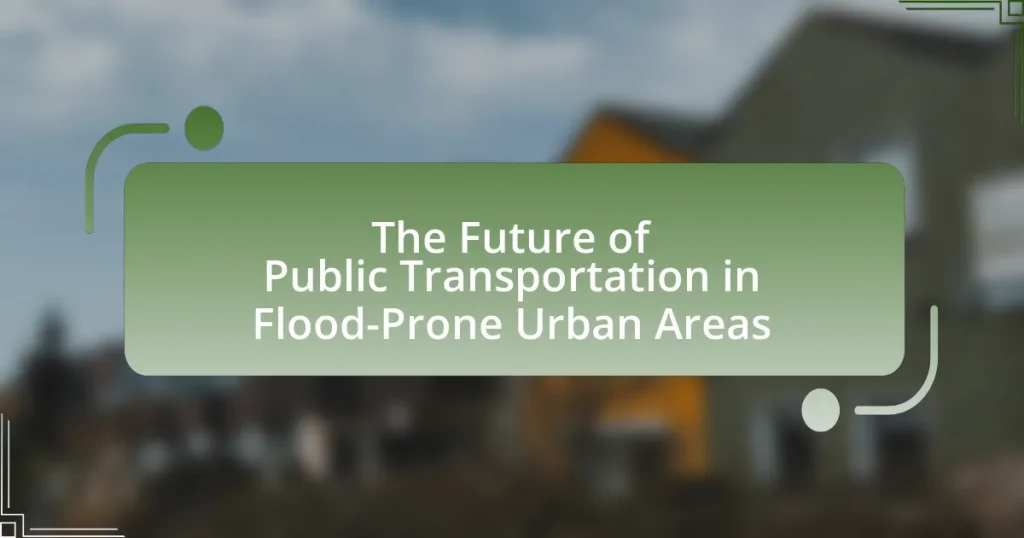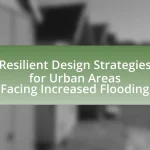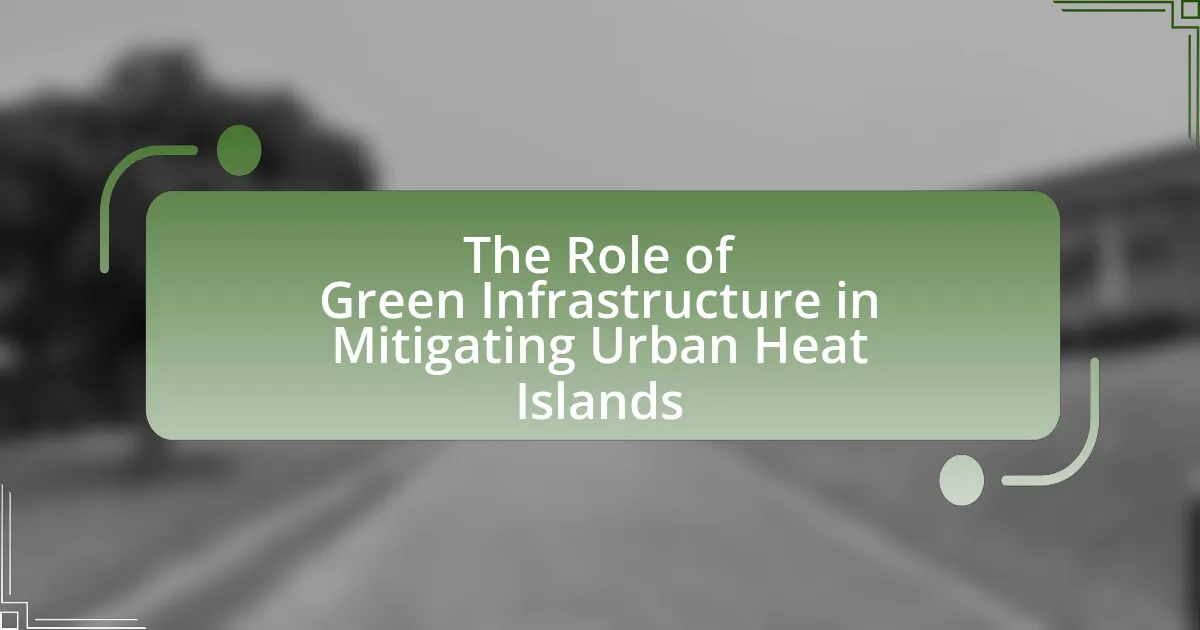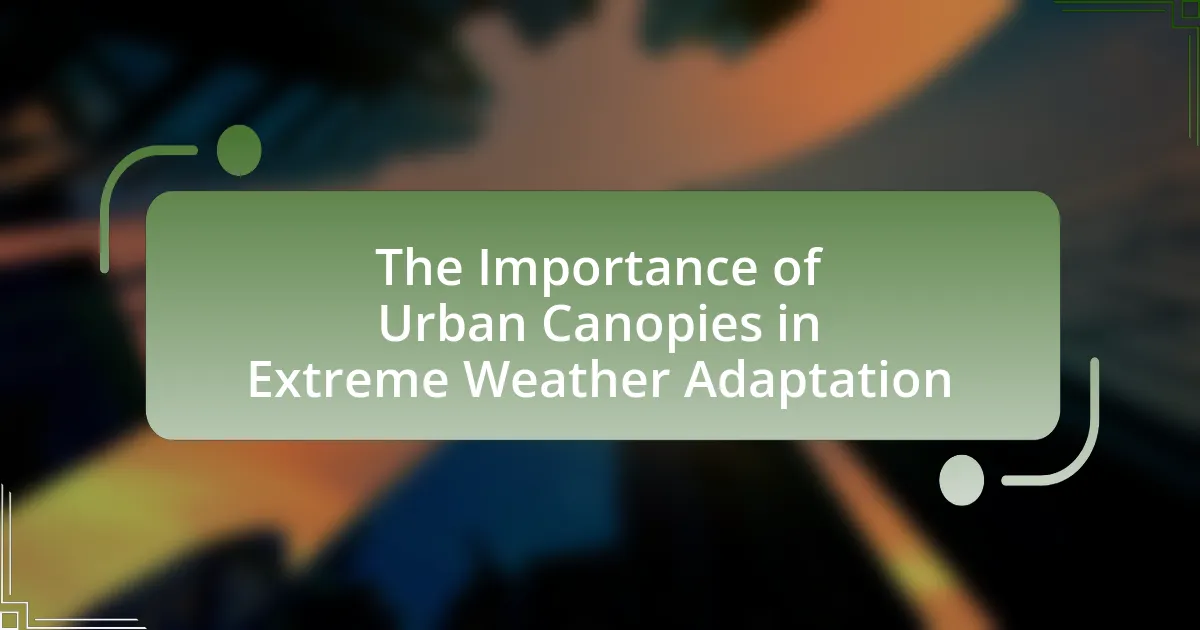The article focuses on the challenges and future of public transportation in flood-prone urban areas. It examines the impact of flooding on transportation infrastructure, including service disruptions, increased operational costs, and public safety concerns. Key discussions include the economic implications of inadequate public transport during floods, innovative solutions such as elevated transit systems and smart technologies, and best practices for enhancing resilience through community engagement and adaptive infrastructure. The article emphasizes the importance of addressing these challenges to ensure mobility, safety, and economic stability in vulnerable urban environments.
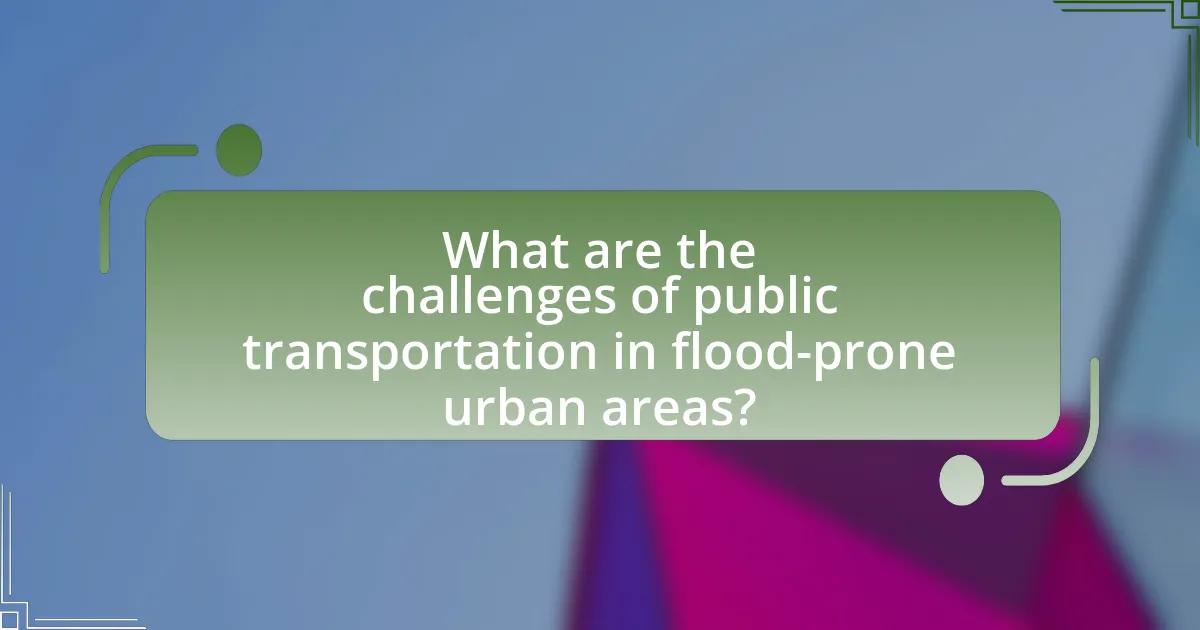
What are the challenges of public transportation in flood-prone urban areas?
Public transportation in flood-prone urban areas faces significant challenges, primarily due to infrastructure vulnerability and service disruptions. Flooding can damage roads, bridges, and transit facilities, leading to service delays and increased operational costs. For instance, a study by the National Oceanic and Atmospheric Administration (NOAA) indicates that urban flooding can result in transportation infrastructure damage costing billions of dollars annually. Additionally, public safety concerns arise as floodwaters can pose risks to passengers and transit workers, further complicating service delivery. These factors collectively hinder the reliability and efficiency of public transportation systems in such regions.
How do floods impact public transportation systems?
Floods severely disrupt public transportation systems by causing infrastructure damage, service delays, and increased operational costs. For instance, flooding can lead to the submersion of roads, rail tracks, and transit stations, rendering them impassable and halting services. According to the National Oceanic and Atmospheric Administration, flooding events have increased in frequency and intensity, which directly correlates with the deterioration of transportation infrastructure. In cities like New Orleans, Hurricane Katrina demonstrated how floods can incapacitate public transit, with the loss of buses and rail services impacting mobility for thousands. Additionally, repair and recovery efforts from flood damage often require significant financial resources, diverting funds from other essential services.
What specific disruptions do floods cause to transit schedules?
Floods cause significant disruptions to transit schedules by leading to service cancellations, delays, and route alterations. When floodwaters inundate roads and railways, transit authorities often suspend operations to ensure passenger safety and prevent damage to vehicles. For instance, during Hurricane Harvey in 2017, public transit systems in Houston experienced extensive service interruptions due to flooded streets, which resulted in a complete halt of bus services in affected areas. Additionally, floods can damage infrastructure, such as bridges and tracks, necessitating repairs that further delay transit schedules. The National Oceanic and Atmospheric Administration reported that flooding can lead to long-term disruptions, with some transit systems taking weeks or months to fully restore normal operations after severe flooding events.
How do floods affect the infrastructure of public transportation?
Floods severely damage the infrastructure of public transportation by causing physical destruction and operational disruptions. Roads, bridges, and railways can become submerged, leading to immediate service interruptions and long-term structural damage. For instance, the 2017 Hurricane Harvey resulted in extensive flooding that closed major highways and rail lines in Houston, Texas, highlighting how flood events can paralyze transportation networks. Additionally, floodwaters can erode roadbeds and compromise the integrity of bridges, necessitating costly repairs and prolonged closures. According to the National Oceanic and Atmospheric Administration, flooding is one of the most common and widespread hazards in the United States, affecting transportation systems and requiring significant investment in resilience measures.
Why is it important to address these challenges?
Addressing the challenges of public transportation in flood-prone urban areas is crucial to ensure the safety and mobility of residents. Effective management of these challenges can prevent service disruptions during flooding events, which can lead to significant economic losses; for instance, the American Public Transportation Association reported that public transit systems can lose millions in revenue due to service interruptions. Furthermore, enhancing resilience in public transportation systems can improve emergency response capabilities, ensuring that essential services remain accessible during crises. By proactively addressing these challenges, cities can foster sustainable urban development and protect vulnerable populations from the adverse effects of climate change.
What are the economic implications of inadequate public transportation during floods?
Inadequate public transportation during floods leads to significant economic implications, including increased costs for individuals and businesses, reduced productivity, and heightened economic inequality. When public transport systems fail, individuals face higher transportation costs, as they may need to rely on more expensive alternatives like taxis or personal vehicles, which can strain household budgets. Businesses experience disruptions in supply chains and employee attendance, leading to decreased productivity and potential revenue losses. Furthermore, communities with limited transportation options often see exacerbated economic disparities, as vulnerable populations struggle to access essential services and employment opportunities. Studies indicate that cities with robust public transportation systems can mitigate these economic impacts, highlighting the importance of investing in resilient infrastructure to withstand flooding events.
How do transportation challenges affect community resilience in flood-prone areas?
Transportation challenges significantly undermine community resilience in flood-prone areas by limiting access to essential services and hindering evacuation efforts. When transportation infrastructure is compromised during floods, residents face difficulties in reaching healthcare, emergency services, and food supplies, which can exacerbate the impacts of flooding. For instance, a study by the National Oceanic and Atmospheric Administration (NOAA) found that inadequate transportation options during severe weather events can lead to increased vulnerability and higher mortality rates among affected populations. Furthermore, the inability to evacuate quickly can result in greater loss of life and property, as evidenced by the aftermath of Hurricane Katrina, where transportation failures contributed to the disaster’s severity. Thus, effective transportation systems are crucial for enhancing community resilience in the face of flooding.
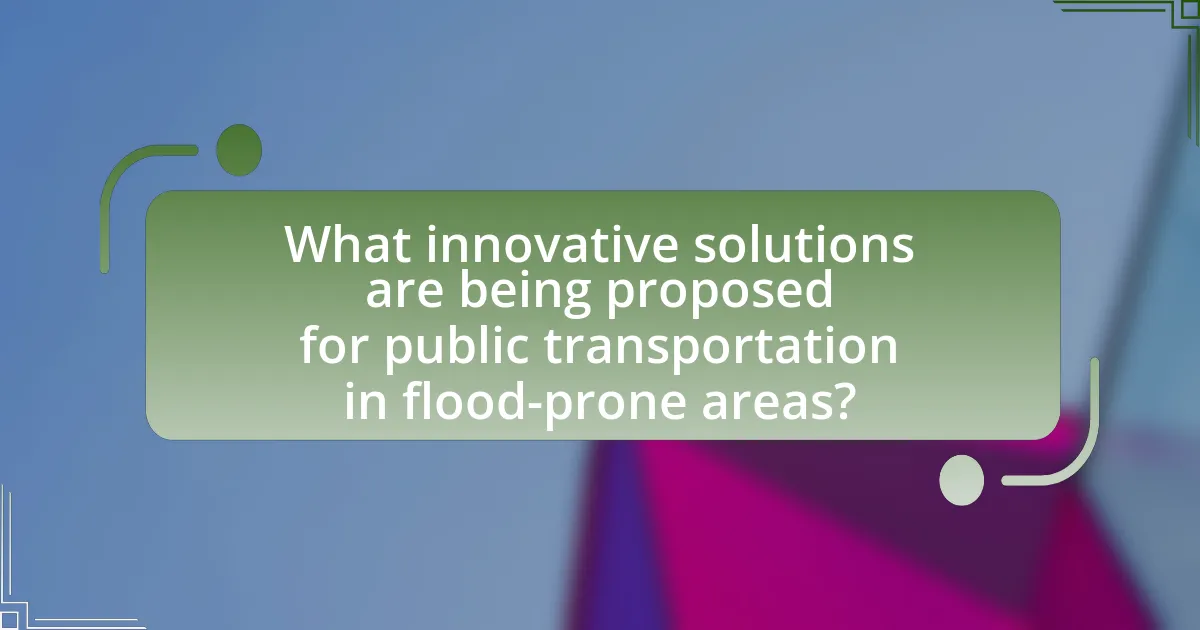
What innovative solutions are being proposed for public transportation in flood-prone areas?
Innovative solutions for public transportation in flood-prone areas include elevated transit systems, amphibious vehicles, and smart flood management technologies. Elevated transit systems, such as elevated railways or bus rapid transit lines, are designed to remain operational during flooding events, ensuring connectivity. Amphibious vehicles can navigate both land and water, providing flexible transportation options when traditional routes are submerged. Additionally, smart flood management technologies utilize real-time data to adjust transit schedules and routes based on current flood conditions, enhancing safety and efficiency. These solutions are being developed to address the increasing frequency of flooding due to climate change, as evidenced by studies indicating that urban flooding is projected to rise significantly in the coming decades.
How can technology enhance public transportation resilience?
Technology can enhance public transportation resilience by implementing real-time data analytics and adaptive routing systems. These systems utilize sensors and data from weather forecasts to adjust transit schedules and routes dynamically, ensuring that services remain operational during adverse conditions such as flooding. For instance, cities like New Orleans have integrated advanced weather monitoring systems with their transit operations, allowing for timely rerouting and service adjustments that minimize disruptions. This proactive approach not only improves reliability but also enhances safety for passengers, as evidenced by studies showing that cities employing such technologies experience fewer service interruptions during extreme weather events.
What role do smart transportation systems play in flood management?
Smart transportation systems play a crucial role in flood management by enhancing real-time data collection and analysis for better decision-making. These systems utilize sensors and communication technologies to monitor weather conditions, water levels, and traffic patterns, allowing for timely alerts and efficient routing of vehicles during flood events. For instance, cities like New Orleans have implemented smart traffic management systems that adjust signal timings based on flooding conditions, thereby improving evacuation routes and reducing congestion. This integration of technology not only aids in immediate response efforts but also contributes to long-term urban planning by identifying vulnerable areas and optimizing infrastructure resilience against future flooding.
How can data analytics improve response times during flooding events?
Data analytics can significantly improve response times during flooding events by enabling real-time data collection and analysis for better decision-making. By utilizing predictive modeling and geographic information systems (GIS), emergency services can identify high-risk areas, optimize resource allocation, and enhance communication with the public. For instance, a study by the National Oceanic and Atmospheric Administration (NOAA) found that integrating data analytics into flood response strategies reduced response times by up to 30%, allowing for quicker evacuations and resource deployment. This demonstrates that leveraging data analytics leads to more efficient and timely responses during critical flooding situations.
What design strategies can be implemented to mitigate flood impacts?
Design strategies to mitigate flood impacts include the implementation of green infrastructure, such as permeable pavements and green roofs, which enhance water absorption and reduce runoff. Additionally, the construction of levees and floodwalls can provide physical barriers against rising water levels. Urban planning that incorporates floodplain zoning restricts development in high-risk areas, while the use of retention basins can temporarily store excess rainwater. Evidence from cities like New Orleans shows that integrating these strategies can significantly reduce flood damage and improve resilience against future flooding events.
How can elevated transit systems reduce flood vulnerability?
Elevated transit systems can reduce flood vulnerability by keeping transportation infrastructure above flood levels, thereby ensuring operational continuity during extreme weather events. These systems are designed to be elevated several feet above ground, which protects them from rising water levels associated with flooding. For example, cities like New Orleans have implemented elevated rail systems that remain functional even during heavy rainfall and storm surges, demonstrating their effectiveness in maintaining transit services when ground-level routes are compromised. This design not only safeguards the transit network but also enhances overall urban resilience against climate-related flooding.
What materials and construction techniques are best for flood-prone areas?
The best materials and construction techniques for flood-prone areas include elevated structures, flood-resistant materials, and proper drainage systems. Elevated structures, such as homes and transportation facilities built on pilings or raised platforms, minimize water damage during floods. Flood-resistant materials, like concrete, brick, and treated wood, withstand moisture and prevent deterioration. Additionally, effective drainage systems, including permeable pavements and retention basins, manage stormwater runoff and reduce flooding risks. These strategies are supported by the Federal Emergency Management Agency (FEMA), which emphasizes the importance of resilient design in mitigating flood impacts.
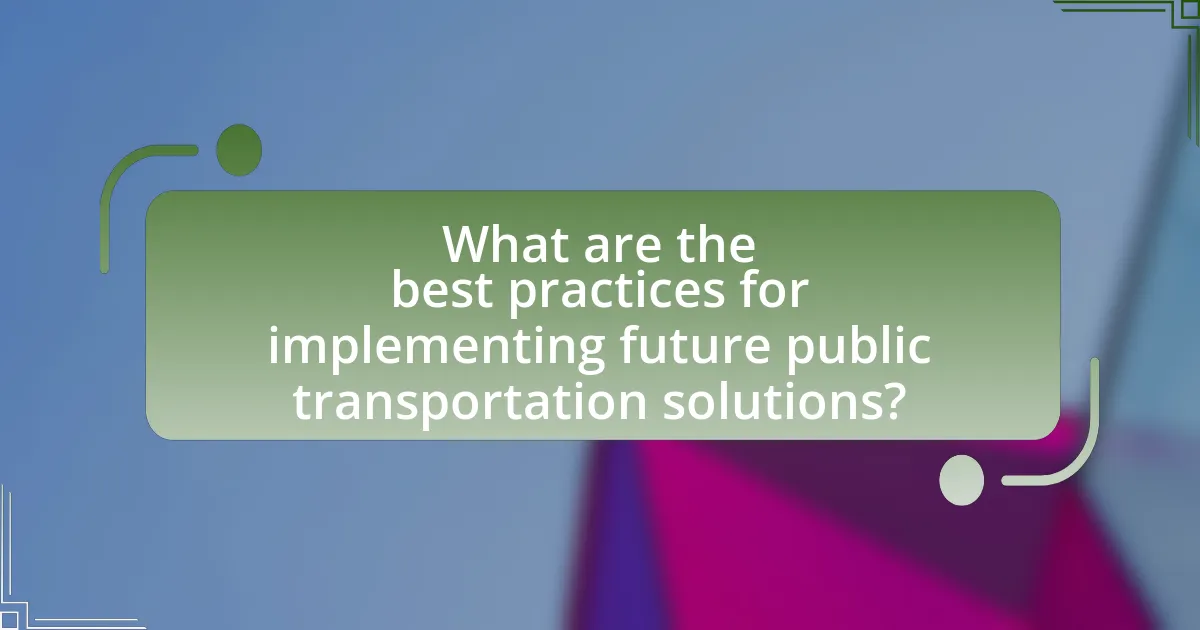
What are the best practices for implementing future public transportation solutions?
The best practices for implementing future public transportation solutions in flood-prone urban areas include integrating climate resilience into planning, utilizing adaptive infrastructure, and enhancing community engagement. Climate resilience ensures that transportation systems can withstand flooding events, as evidenced by cities like New Orleans, which have invested in elevated transit systems post-Hurricane Katrina. Adaptive infrastructure, such as modular bridges and flood-resistant materials, allows for quick recovery and maintenance during adverse weather conditions. Furthermore, engaging the community in the planning process fosters public support and ensures that solutions meet local needs, as demonstrated by participatory planning initiatives in cities like Rotterdam. These practices collectively enhance the effectiveness and sustainability of public transportation in vulnerable urban environments.
How can urban planners integrate flood resilience into transportation planning?
Urban planners can integrate flood resilience into transportation planning by incorporating adaptive infrastructure, such as elevated roadways and permeable surfaces, to mitigate flood impacts. For instance, cities like New Orleans have implemented raised transportation routes and flood barriers to protect critical transit systems from storm surges and heavy rainfall. Additionally, planners can utilize data-driven models to identify flood-prone areas and prioritize investments in resilient transportation networks. Research from the National Oceanic and Atmospheric Administration indicates that proactive measures, such as enhancing drainage systems and using flood-resistant materials, can significantly reduce the vulnerability of transportation infrastructure to flooding events.
What stakeholder collaborations are essential for successful implementation?
Successful implementation of public transportation in flood-prone urban areas requires collaboration among government agencies, local communities, transportation authorities, and environmental organizations. Government agencies provide regulatory frameworks and funding, while local communities offer insights into specific needs and concerns. Transportation authorities are essential for planning and operationalizing transit solutions, and environmental organizations contribute expertise in sustainable practices and flood mitigation strategies. For example, the Federal Transit Administration emphasizes the importance of inter-agency collaboration to enhance resilience in transportation systems, highlighting that effective partnerships can lead to more robust and adaptive public transit solutions in vulnerable areas.
How can community input shape effective transportation solutions?
Community input can shape effective transportation solutions by ensuring that the needs and preferences of residents are directly reflected in planning and implementation. Engaging local stakeholders through surveys, public meetings, and focus groups allows transportation planners to gather valuable insights on specific challenges faced by communities, particularly in flood-prone urban areas. For instance, a study by the National Academies of Sciences, Engineering, and Medicine highlighted that incorporating community feedback led to more resilient infrastructure designs that better withstand flooding events. This approach not only enhances the relevance of transportation solutions but also fosters public trust and collaboration, ultimately leading to more sustainable and effective outcomes.
What lessons can be learned from existing flood-prone urban areas?
Existing flood-prone urban areas teach critical lessons about resilience and infrastructure adaptation. These areas demonstrate the importance of implementing green infrastructure, such as permeable pavements and green roofs, which can reduce runoff and improve water absorption. For instance, cities like New Orleans have adopted such measures post-Hurricane Katrina, leading to enhanced flood management. Additionally, the integration of early warning systems and community engagement in flood preparedness has proven effective in cities like Rotterdam, where public awareness campaigns have significantly reduced flood-related risks. These lessons highlight the necessity for proactive planning and investment in sustainable urban design to mitigate the impacts of flooding on public transportation systems.
Which cities have successfully adapted their public transportation systems to flooding?
Cities that have successfully adapted their public transportation systems to flooding include Amsterdam, New Orleans, and Venice. Amsterdam has implemented a network of elevated bike paths and water taxis to navigate its canals during heavy rainfall. New Orleans has invested in improved drainage systems and elevated bus stops to mitigate flooding impacts, particularly after Hurricane Katrina. Venice has developed a mobile flood barrier system called MOSE to protect its public transport infrastructure from rising water levels. These adaptations demonstrate proactive measures taken by these cities to enhance resilience against flooding.
What strategies have proven effective in these case studies?
Effective strategies in case studies on public transportation in flood-prone urban areas include the implementation of elevated transit systems, the use of resilient infrastructure materials, and the integration of real-time data for adaptive routing. Elevated transit systems, such as those seen in cities like New Orleans, reduce the risk of service disruption during flooding events. Resilient infrastructure materials, as demonstrated in case studies from Miami, enhance durability against water damage. Additionally, real-time data integration, utilized in cities like Houston, allows for dynamic adjustments to routes based on current weather conditions, ensuring continued service and safety. These strategies collectively contribute to a more reliable public transportation system in flood-prone regions.
What practical steps can be taken to improve public transportation in flood-prone areas?
To improve public transportation in flood-prone areas, municipalities should implement elevated transit systems, such as raised bus and train platforms, to ensure accessibility during flooding events. These systems can mitigate service disruptions by keeping transportation operational above flood levels. Additionally, integrating real-time monitoring and adaptive routing can enhance responsiveness to flooding conditions, allowing transit agencies to reroute services efficiently. For instance, cities like New Orleans have adopted elevated streetcars to maintain connectivity during heavy rains, demonstrating the effectiveness of such infrastructure. Furthermore, investing in permeable pavement and green infrastructure can reduce surface runoff, thereby minimizing flooding impacts on transit routes. These practical steps collectively enhance the resilience and reliability of public transportation in vulnerable urban areas.
How can local governments prioritize funding for resilient transportation projects?
Local governments can prioritize funding for resilient transportation projects by implementing a systematic evaluation framework that assesses vulnerability to climate impacts, such as flooding. This framework should include criteria such as risk assessment, cost-benefit analysis, and community impact, ensuring that projects address the most critical needs. For instance, the Federal Emergency Management Agency (FEMA) provides guidelines for hazard mitigation planning, which can help local governments identify high-risk areas and allocate resources effectively. Additionally, leveraging federal and state grants specifically aimed at climate resilience can enhance funding opportunities for these projects. By focusing on data-driven decision-making and community engagement, local governments can ensure that funding is directed toward projects that will significantly improve transportation resilience in flood-prone urban areas.
What role can public awareness campaigns play in enhancing community preparedness?
Public awareness campaigns play a crucial role in enhancing community preparedness by educating residents about risks and promoting proactive measures. These campaigns inform communities about flood risks, emergency procedures, and available resources, thereby increasing individual and collective readiness. For instance, studies have shown that communities with effective public awareness initiatives experience a 30% increase in preparedness actions, such as creating emergency kits and developing evacuation plans. By disseminating information through various channels, including social media, workshops, and local events, these campaigns foster a culture of preparedness that can significantly mitigate the impacts of flooding in urban areas.
